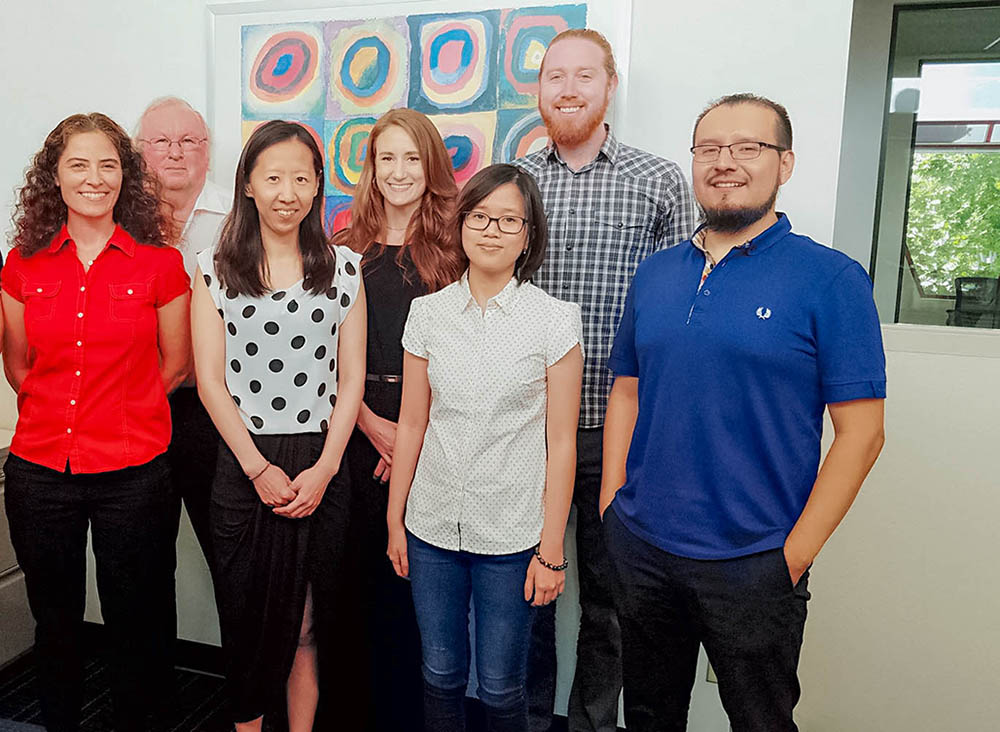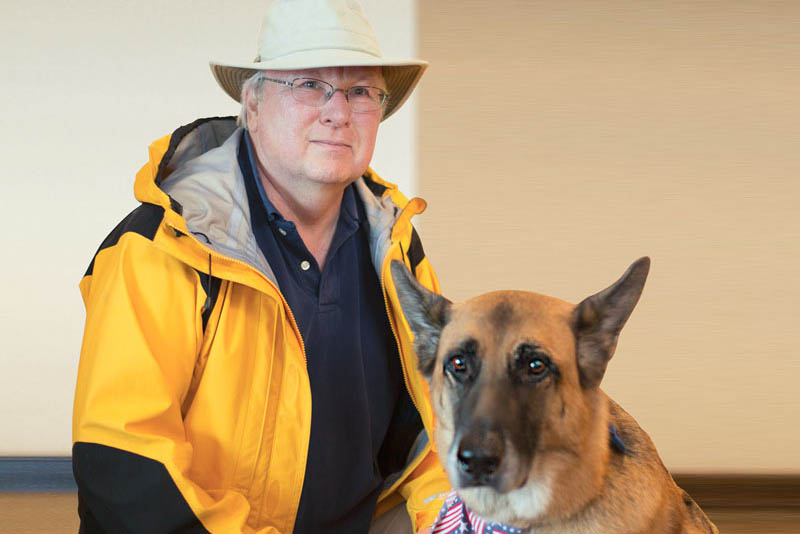The unique backgrounds and versatile skillsets of Dimensional Insight’s staff help push us to deliver the most innovative and powerful services possible. I recently sat down with one of the members of our team, John Stoveken. Even if you don’t recognize the name, you likely know John’s work or his adorable mixed-breed rescue dog Hendrix. John has worked at Dimensional Insight for 16 years, but he was actually involved with the company years before he officially joined the team.
I talked with John about his work and fascinating past to get some insight into the Dimensional Insight San Diego office, InterReport, and more.
What was your background before coming to Dimensional Insight?
I graduated from college in 1974 with a degree in biochemistry and bioengineering. I worked in chemistry labs for a while, and then a friend of mine started a little software company up in Canada, so I went and moved to Canada to join that.
This little company did a lot of business applications and some executive information systems. Kind of like data roll-ups, but we weren’t using Dimensional Insight technology, just flat databases. I worked there for a while, but I started looking for other work once the company started downsizing. This company that started out at six people had grown to 120, but it was working its way back to six people again.
I next moved back to the states and went to work for PerkinElmer, a company that I had worked for as a chemist previously. Now I was coming back to work with its decision support group. We did a survey of products at the time and decided Diver and BusinessObjects were worth testing for our users. We did a pilot project, and lots of people wanted Diver, and only one person wanted BusinessObjects, so we started using Diver as the corporate decision support tool at PerkinElmer.
After becoming familiar with the product, I spoke at a number of user conferences. Then around 2002, PerkinElmer was bought by another company, and the bean counters came in and deemed me ‘redundant’. So I did the only thing that made any sense at the time: I called up Fred and said, “Hey, I spoke at a bunch of your User Conferences, do you need me?” My wife and I spent three weeks scuba diving in the Galapagos Islands, and then I started working for Dimensional Insight.
So you transitioned from chemistry to coding. Was that difficult?
Not as much as you might think. Part of the transition is that chemists basically take lots of little things, glom them together, and come up with something big. I had done synthetic chemistry — making molecules and DNA. And as it turns out, some of that logic and programming are the same. You take little bits, glue them together, and get something big and, hopefully, functional!
What has your role been at Dimensional Insight?
I started working at Dimensional Insight as a consultant in the Northeast. (People who have attended user conferences may know me as the guy who walks the service dog at Dimensional Insight events.) However, after a year or so, InterReport (Dimensional Insight’s software-as-a-service product) became my full-time job. I was doing InterReport mostly on my own for a while, with the help of the god-like Mike Phillips. Basically, the two of us got it going: he on the technical side, and me on most everything else.
How did InterReport get started?
Well, at PerkinElmer we had transitioned to Diver from file-oriented products. You created a Diver model, and it was stored locally to your system, and you interacted directly with the files. That was a great improvement. DiveLine came of age in the late 90’s, so once I joined Dimensional Insight (in 2002), I started talking to Fred, saying, “It seems the client-server technology is getting robust enough, maybe we can do something as software-as-a-service…” Many months and lines of code later, InterReport was born.
What do your customers like most about InterReport?
They get all the benefits of Dimensional Insight’s technology, such as the client tools, but the back-end configuration, data verification, and everything else is done for them. On a number of the installs, we get data from multiple data sources. For example, we may get data from a data collection company, Nielsen, and the customer’s internal data sets, and we merge them together. All the technical requirements are on us. The customer gets the benefit of all the client tools without having to do the backend.
Also, as we’ve done hundreds of installs, the customers get the benefit of a broader experience on our side. We’ve been working in the industry for 15 years. So we know a lot about it and have addressed a lot of wacky things for customers that we can then extend to others. So there’s experience and shared knowledge. If we do some specific work for a customer, that work is owned by the customer, but the knowledge that we came up with on how to approach it and solve their issues, that’s ours. And all our other customers will benefit from that.
Any feature or secret for any Dimensional Insight tools you wish customers knew more about?
One thing that is probably underused is the data broadcast functionality. The fact that I can go send an email to 100 vendors with the status of their specific work, and once configured, it’s zero overhead to me. Being able to push information out to the field is something that customers don’t use as much, but it is very powerful.
The other thing customers could take advantage of more is the non-data distribution, such as the document support that we now have in the product. You know, here’s my technical manual, here are some PDFs. That’s something not many of my users have taken advantage of. And that’s something that’s pretty unique to us.
Where do you see the industry going in the future? What’s your and Dimensional Insight’s part in that?
I don’t have a great crystal ball at the moment, but we’re certainly moving to mobile clients. We’re definitely getting pulled into that world.
I also see location support becoming much more widespread and robust. Some newer applications of the technology in Dimensional Insight software would be useful in the field. For example, some salesperson in the field could say, “My phone knows where I am, now what customers of mine are nearby?” and things like that.
You’re credited with starting the San Diego Office. How did that happen?
My wife had lived with me outside Toronto, Canada, and then in Connecticut. Around 2006/2007 she announced to me that “living in Canada and Connecticut has been nice, but the only ice I want to see now is in my glass.”
So I chatted with Fred, and he said, “Okay, go move some place and we’ll open an office there.” He was strongly suggesting Florida, but it’s too humid and the bugs are too big. So we looked around, and ended up coming out here to San Diego. We opened the Dimensional Insight San Diego office in early 2008 and have carried on from there. It started with just two employees, and now here we are with seven of us working in the office.
What’s the culture like at the San Diego office?
We’re in California, so we’re definitely a casual office. Our work may be serious, but we don’t always have to be. I’m sitting here right now looking at a hummingbird and a flower outside the window. It’s lovely. As far as process, we’re a team-oriented group, so we’ll hassle each other when we start hitting walls. You see we’re really a bunch of programmers. We have Rachel who’s a project manager out here, but the rest of us are doing programming. Programmers have a lot of pride – they want to solve things themselves, but if you keep banging your head against a wall, it’s time to find someone else. Basically, we’re casual but hard working, and encourage a lot of collaboration.

What do you enjoy doing outside the office?
I love traveling, scuba diving (yes, I’m a real diver), and exploring nature. I’ve gotten slothful in my old age, so a lot of my free time now is spent walking the aforementioned service dog Hendrix all over San Diego. The travelling has toned down a bit, so my wife and I visit local spots much more these days, such as the San Diego Zoo, which we’re in walking distance of.
Scuba diving has taken a backseat for a while. We need to get some more traveling gear and get back in the water soon.
Traveling and diving – what are some of your favorite spots and memories?
My favorite vacations have been two safaris to Africa. First to Kenya, visiting vast grasslands full of critters, and second to Zimbabwe/Botswana. It was interesting waking up to a hippo in your campsite on the Okavango Delta and being chased on-foot by a herd of elephants and a rhino.
As far as diving, the Galapagos had the most spectacular life we’ve seen, so that is a top destination, but Cozumel with its drift diving and margaritas (after dives) is certainly a favorite as well.
- DIUC19 Day 4: Final Training and Farewell - August 8, 2019
- DIUC19 Day Three: Sessions and Product Showcase - August 7, 2019
- 4 Ways to Sabotage a Data Analytics Project - July 25, 2019



